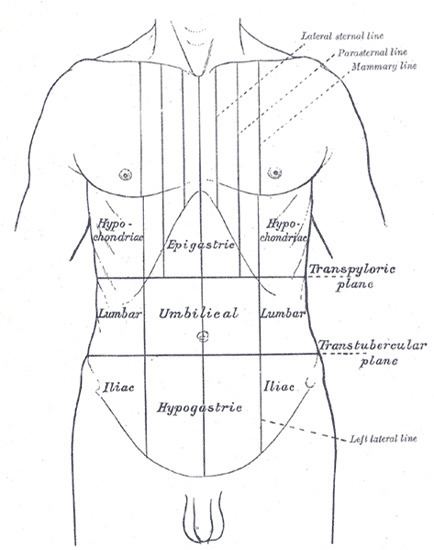Abdominal pain, also known as stomach pain or tummy ache, is a common symptom associated with both temporary, non-serious disorders and more serious conditions.
Common causes of pain in the abdomen include gastroenteritis and irritable bowel syndrome. In a third of cases the exact cause is unclear. About 10% of people have a more serious underlying condition such as appendicitis, leaking or ruptured abdominal aortic aneurysm, diverticulitis, or ectopic pregnancy. Determining the cause can be difficult, because many diseases can cause this symptom.
The most frequent reason for abdominal pain are gastroenteritis (13%), irritable bowel syndrome (8%), urinary tract problems (5%), inflammation of the stomach (5%) and constipation (5%). In about 30% of cases, the cause is not determined. About 10% of cases have a more serious cause including gallbladder (stones or biliary dyskinesia) or pancreas problems (4%), diverticulitis (3%), appendicitis (2%) and cancer (1%). More common in those who are older, mesenteric ischemia and abdominal aortic aneurysms are other serious causes.
A more extensive list includes the following:
GastrointestinalGI tractInflammatory: gastroenteritis, appendicitis, gastritis, esophagitis, diverticulitis, Crohn's disease, ulcerative colitis, microscopic colitisObstruction: hernia, intussusception, volvulus, post-surgical adhesions, tumours, severe constipation, hemorrhoidsVascular: embolism, thrombosis, hemorrhage, sickle cell disease, abdominal angina, blood vessel compression (such as celiac artery compression syndrome), superior mesenteric artery syndrome, postural orthostatic tachycardia syndromeDigestive: peptic ulcer, lactose intolerance, coeliac disease, food allergiesGlandsBile systemInflammatory: cholecystitis, cholangitisObstruction: cholelithiasis, tumoursLiverInflammatory: hepatitis, liver abscessPancreaticInflammatory: pancreatitisRenal and urologicalInflammation: pyelonephritis, bladder infection, indigestionObstruction: kidney stones, urolithiasis, urinary retention, tumoursVascular: left renal vein entrapmentGynaecological or obstetricInflammatory: pelvic inflammatory diseaseMechanical: ovarian torsionEndocrinological: menstruation, MittelschmerzTumors: endometriosis, fibroids, ovarian cyst, ovarian cancerPregnancy: ruptured ectopic pregnancy, threatened abortionAbdominal wallmuscle strain or traumamuscular infectionneurogenic pain: herpes zoster, radiculitis in Lyme disease, abdominal cutaneous nerve entrapment syndrome (ACNES), tabes dorsalisReferred painfrom the thorax: pneumonia, pulmonary embolism, ischemic heart disease, pericarditisfrom the spine: radiculitisfrom the genitals: testicular torsionMetabolic disturbanceuremia, diabetic ketoacidosis, porphyria, C1-esterase inhibitor deficiency, adrenal insufficiency, lead poisoning, black widow spider bite, narcotic withdrawalBlood vesselsaortic dissection, abdominal aortic aneurysmImmune systemsarcoidosisvasculitisfamilial Mediterranean feverIdiopathicirritable bowel syndrome (affecting up to 20% of the population, IBS is the most common cause of recurrent, intermittent abdominal pain)Acute abdomen can be defined as severe, persistent abdominal pain of sudden onset that is likely to require surgical intervention to treat its cause. The pain may frequently be associated with nausea and vomiting, abdominal distention, fever and signs of shock. One of the most common conditions associated with acute abdominal pain is acute appendicitis.
Traumatic: blunt or perforating trauma to the stomach, bowel, spleen, liver, or kidneyInflammatory:Infections such as appendicitis, cholecystitis, pancreatitis, pyelonephritis, pelvic inflammatory disease, hepatitis, mesenteric adenitis, or a subdiaphragmatic abscessPerforation of a peptic ulcer, a diverticulum, or the caecumComplications of inflammatory bowel disease such as Crohn's disease or ulcerative colitisMechanical:Small bowel obstruction secondary to adhesions caused by previous surgeries, intussusception, hernias, benign or malignant neoplasmsLarge bowel obstruction caused by colorectal cancer, inflammatory bowel disease, volvulus, fecal impaction or herniaVascular: occlusive intestinal ischemia, usually caused by thromboembolism of the superior mesenteric arteryLocation
Upper middle abdominal painStomach (gastritis, stomach ulcer, stomach cancer)Pancreas pain (pancreatitis or pancreatic cancer, can radiate to the left side of the waist, back, and even shoulder)Duodenal ulcer, diverticulitisAppendicitis (starts here, after some time moves to lower right abdomen)Upper right abdominal painLiver (caused by hepatomegaly due to fatty liver, hepatitis, or caused by liver cancer, abscess)Gallbladder and biliary tract (gallstones, inflammation, roundworms)Colon pain (below the area of liver – bowel obstruction, functional disorders, gas accumulation, spasm, inflammation, colon cancer)Upper left abdominal painSpleen pain (splenomegaly)PancreasColon pain (below the area of spleen – bowel obstruction, functional disorders, gas accumulation, spasm, inflammation, colon cancer)Middle abdominal pain (pain in the area around belly button)Appendicitis (starts here)Small intestine pain (inflammation, intestinal spasm, functional disorders)Lower abdominal pain (diarrhea, colitis and dysentery)Lower right abdominal painCecum (intussusception, bowel obstruction)Appendix point (Appendicitis location)Lower left abdominal paindiverticulitis, sigmoid volvulus, obstruction or gas accumulationPelvic painbladder (cystitis, may be secondary to diverticulum and bladder stone, bladder cancer)pain in women (uterus, ovaries, fallopian tubes)Right lumbago and back painliver pain (hepatomegaly)right kidney pain (its location below the area of liver pain)Left lumbago and back painless in spleen painleft kidney painLow back painkidney pain (kidney stone, kidney cancer, hydronephrosis)Ureteral stone painWhen a health care practitioner assesses a patient to determine the etiology and subsequent treatment for abdominal pain the history of the presenting complaint and physical examination should derive a diagnosis in over 90% of cases.
Investigations that aid diagnosis include
Blood tests including full blood count, electrolytes, urea, creatinine, liver function tests, pregnancy test, amylase and lipase.UrinalysisImaging including erect chest X-ray and plain films of the abdomenAn electrocardiograph to rule out a heart attack which can occasionally present as abdominal painIf diagnosis remains unclear after history, examination and basic investigations as above then more advanced investigations may reveal a diagnosis. These as such would include
Computed tomography of the abdomen/pelvisAbdominal or pelvic ultrasoundEndoscopy and colonoscopy (not used for diagnosing acute pain)Butylscopolamine (Buscopan) is used to treat cramping abdominal pain with some success.
Abdominal pain is the reason about 3% of adults see their family physician. Rates of emergency department visits in the United States for abdominal pain increased 18% from 2006 through 2011. This was the largest increase out of 20 common conditions seen in the ED. The rate of ED use for nausea and vomiting also increased 18%.

